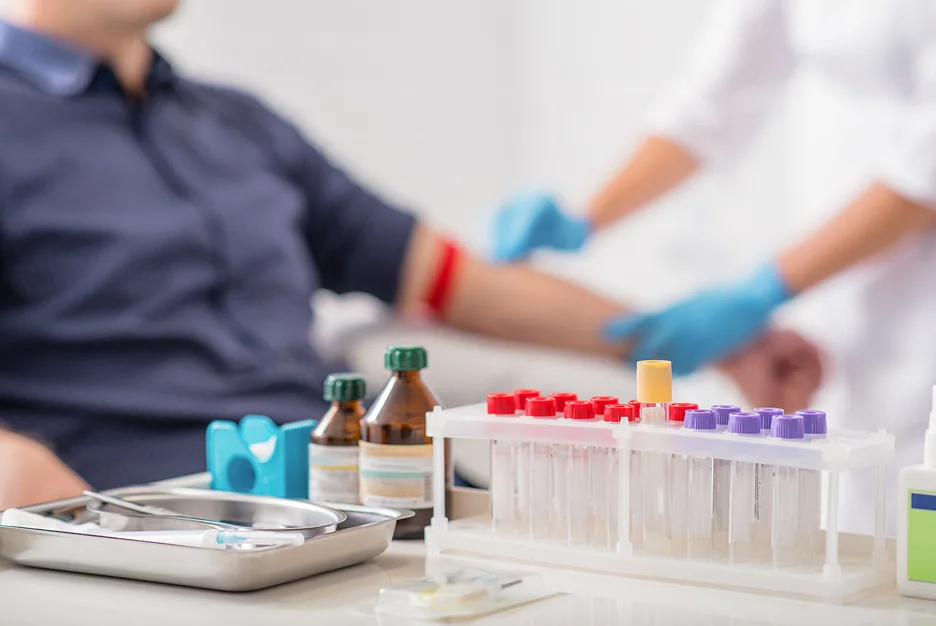The Importance of Detecting Biogenic Amines in Food Samples
Biogenic amines are naturally occurring compounds formed in various foods as they undergo decay.
While present at low levels in most foods, bioamines can cause adverse reactions in humans if levels become too high. It is therefore crucial to monitor bioamine content in foods to ensure safety.
Biosensors have emerged as a promising solution for bioamine detection, providing sensitive, on-site analysis.
Enzymatic Biosensors
Diamine oxidase (DAO) is a vital enzyme involved in the metabolism of biogenic amines in vivo. In humans, DAO is predominantly expressed in the intestines and liver where it plays a key role in metabolizing histamine and other biogenic amines absorbed from dietary sources.
As an oxidative deaminase, DAO catalyzes the reaction of oxidatively deaminating biogenic amines like histamine, putrescine, and cadaverine into the corresponding aldehydes. Due to this selective enzymatic activity, DAO biosensors have emerged as an important class of bioanalytical tools for detecting biogenic amines present in food and biological samples.
Diamine Oxidase Biosensors
This ensures DAO retains its native conformation and catalytic activity. In the presence of a biogenic amine substrate, DAO mediates its oxidative deamination to generate hydrogen peroxide as a product.
The produced hydrogen peroxide is then detected electrochemically through the transducer, typically near DAO’s optimal redox potential of around +0.6V vs Ag/AgCl, yielding a proportional signal output correlated to analyte concentration.
Careful optimization of immobilization conditions like matrix materials, linkage chemistries and buffer components is key to preserving high enzyme activity and achieving reliable biosensor performance over multiple assays.
Histamine biosensors
As one of the major biogenic amines of concern, histamine biosensors have received extensive attention from researchers.
High histamine levels are toxicologically significant and regulated in certain foods like fish due to scombroid poisoning risks. Hence, determining histamine content accurately and rapidly is important for food quality control and safety.
Most histamine biosensors leverage the same DAO-mediated biocatalytic detection principle. DAO is immobilized as the biorecognitive element on various electrochemical transducers to selectively oxidize histamine near its optimal potential of around +0.6V vs Ag/AgCl.
This generates an electroactive response proportional to histamine concentration which is then quantified amperometrically.
Significant efforts have focused on modifying electrode surfaces, optimizing immobilization strategies and incorporating signal amplification techniques to develop highly sensitive histamine biosensors with low detection limits suitable for regulatory compliance and on-site analysis needs.
Electrochemical Biosensors: Principles of Electrochemical Detection
Biosensors utilizing electrochemical transduction principles measure the enzymatic conversion of analytes into chemical products detectable through techniques like amperometry or voltammetry.
The current or potential signal generated at the sensor interface is directly proportional to analyte concentration in the sample. Amperometric detection involves measuring current through biochemical oxidation/reduction reactions at fixed potentials, providing high sensitivity for rapidly responding substrates.
Voltammetric techniques like cyclic voltammetry characterize electron transfer kinetics regardless of rate.
Performance Optimization
Sensor performance metrics must be tailored for practical clinical applications. Sensitivity is optimized through strategies such as cascade signal amplifiers utilizing additional promoter enzymes or nanomaterials, which can enhance signal strength from low analyte levels.
Interferent rejection is achieved by selective coatings, robust reference electrodes operating at optimized potentials to discriminate target signals.
Reproducibility and assay stability also rely greatly on robust immobilization of bioreagents, maintaining precision over multiple readings. Integrated fluidics can further lower sample and reagent volumes required per assay.
Applications: Glucose Monitoring
Advancements in microfabrication techniques and materials science have enabled the miniaturization of electrochemical biosensors suitable for continuous glucose monitoring applications.
Subcutaneous sensor implants are now able to wirelessly transmit real-time glucose level data to handheld receivers. This opens possibilities for improved glycemic management in diabetes through frequent measurement and trend analysis versus discrete finger-prick tests.
Further research aims to extend sensor lifetime towards approximately 1 week of continuous operation per insertion.
Disease Biomarker Detection
Beyond glucose, electrochemical biosensors also show promise as point-of-care diagnostic tools for efficiently measuring cardiac biomarkers and inflammatory markers indicative of various disease states.
For example, assays detecting troponin, CK-MB, myoglobin and other protein markers can support rapid evaluation and triage of suspected cardiac event patients.
Similarly, C-reactive protein (CRP) is an acute phase reactant tied to inflammation levels; bedside CRP detection aids quick assessment of bacterial infection symptoms.
Miniaturized, multiplexed biosensing platforms may eventually incorporate panels of clinically relevant biomarkers for comprehensive diagnostic profiling directly in physician offices or hospital emergency rooms.
Detection Methods Amperometric Detection
Amperometric detection is well-suited for quantifying the current generated from enzymatic redox reactions occurring at electrochemical biosensor interfaces.
This involves measuring the current at a fixed applied potential as the analyte is enzymatically converted. Amperometric biosensors typically exhibit a linear response profile directly correlating to analyte concentration within a useful detection range.
Additional techniques such as cyclic voltammetry provide characterization data on reaction kinetics and thermodynamics without concentration dependence. This aids understanding enzyme behavior and reaction mechanisms.
Factors Influencing Performance
Key performance indicators for detection methods are sensitivity, detection limits, linear range and selectivity. Sensitivity towards low analyte levels is maximized through design aspects like enhanced electrode surfaces, expanded biomolecule loading and cascade amplification systems.
Detection limits refer to the lowest reliably measurable concentration and depend on signal-to-noise characteristics. Interference rejection ensures specificity towards target analytes.
Applications in Clinical Practice Point-Of-Care Testing

Bedside testing using biosensors provides rapid results at or near the site of patient care. This allows for more expedited clinical decisions compared to sending samples to centralized laboratories.
Point-of-care devices empower self-monitoring, improving management of chronic health issues through frequent testing. For example, portable glucose monitors aid tight glycemic control in diabetes. Home testing also benefits conditions like coagulation disorders and hypertension that require ongoing monitoring.
Chronic Disease Management
Continuous biosensing holds promise for more proactive care of chronic illnesses through increased surveillance abilities.
Implantable or wearable glucose monitors may help reduce long-term health risks and costs associated with diabetes through closer tracking of trends to guide lifestyle and medication adjustments in real-time.
Similarly, wearable heart rate and blood pressure sensors could facilitate more aggressive blood pressure management through instantaneous alerts of unsafe levels. Biosensors also aid drug delivery verification in conditions like anticoagulation that require individualized dosing.
The Role of Diamine Oxidase in Quantitative Biogenic Amine Analysis via Biosensing
The basic principle of biogenic amine biosensors involves utilizing the selective enzymatic activity of diamine oxidase (DAO).
DAO is an oxidative deaminase that catalyzes the reaction of oxidatively deaminating common biogenic amines like histamine, putrescine, and cadaverine. This converts the amines into their corresponding aldehyde forms through removal of the amino group and addition of an alcohol group.
During this process, DAO generates hydrogen peroxide as one of the products. The produced hydrogen peroxide can then be readily detected using various methods such as electrochemical and optical sensing.
This detection provides the basis for quantification of the biogenic amine analyte concentration in a given sample. By leveraging this selective DAO-mediated reaction, biosensors have emerged as effective analytical tools for detecting target biogenic amines present in foods and biological fluids.
A Simple DAO-based Biosensor Design
A team of researchers developed a simple, versatile biosensor design for quantifying biogenic diamines using diamine oxidase (DAO) immobilized within cotton threads and an oxygen sensor for transducing the analytical signal.
The porous cotton material provided a biocompatible matrix for retaining the DAO enzyme’s bioactivity through physical adsorption onto the threads. Cut sections of the enzyme-loaded cotton were then placed atop the oxygen sensor’s surface.
When exposed to biogenic amine substrates, DAO within the threads catalyzed the oxidative deamination reaction to produce hydrogen peroxide. The associated oxygen sensor functioned as an electrochemical transducer through its ability to generate an amperometric current signal directly proportional to local H2O2 concentrations.
This allowed for indirect, real-time detection of generated peroxide corresponding to levels of the biogenic amine analyte.
The immobilization approach employing inexpensive cotton threads resulted in a simple, disposable biosensor design capable of quantifying various biogenic amine targets.
The versatility and ease of fabrication offered potential for portable, decentralized biogenic amine analyses applicable to various fields including food and environmental monitoring.
Human Diamine Oxidase
Diamine oxidase (DAO) is predominantly expressed in the intestines and liver of humans, where it plays an important physiological role in metabolizing biogenic amines that are consumed through dietary intake.
Upon ingestion, biogenic amines such as histamine and putrescine are absorbed into circulation from the gastrointestinal tract. DAO then acts to enzymatically degrade these amines before they can exert pharmacological effects in other tissues.
The enzyme selectively catalyzes the oxidative deamination of biogenic amine substrates like histamine and putrescine. Through this reaction, DAO converts the amines to the corresponding aldehyde and ammonia.
This metabolic pathway helps regulate amine levels in the body and prevent any harmful interactions, as many biogenic amines are known to function as pharmacological mediators.
A deficiency in DAO activity can thus compromise its protective metabolizing effects, rendering individuals more susceptible to biogenic amine intolerances and associated hypersensitivity reactions after dietary amine intake.
Conclusions

This review has highlighted the potential of electrochemical biosensing platforms selectively leveraging the metabolic activity of diamine oxidase for quantitative analysis applications involving biogenic amines.
DAO-based electrochemical biosensors have shown feasibility in quantifying amines of interest found in complex sample matrices. On-going work continues driving miniaturization of these biosensing technologies toward portable, near-patient diagnostic device formats suitable for point-of-care clinical applications and decentralized food and environmental monitoring needs.
Further advancing performance metrics such as sensitivity, specificity and longevity remains imperative alongside expanding the range of quantifiable biogenic amine analytes. Continuous refinement of bioreceptor immobilization strategies and transducer element designs also aim to improve analytical figures of merit.
Looking ahead, additional validation using real-world samples will be important to substantiate clinical utility. Through persistent multidisciplinary collaboration, electrochemical biosensing employing DAO shows promise as a quantitative tool customizable for various biogenic amine monitoring platforms.
